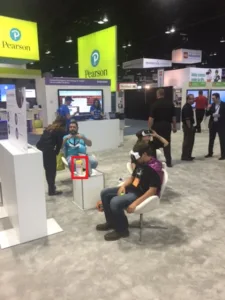After prowling the sessions and conference hall of ISTE 2016 (the largest ed-tech conference held in the U.S. with over 16,000 participants hailing  from 76 countries), I came to a stark and grim realization. With over forty-six 3D-VR-AR-related sessions and more than thirteen 3D and VR vendors in the exhibit hall, I met only two companies (and just a few presenters/educators) who actually “get” it. These two companies, AVRover and Unity, both understand and are aiming to address the vision comfort issues plaguing the emerging VR industry: eye strain, dizziness, headaches, nausea, et al. Based on many interviews, the biggest players in the field (Google, Samsung, and Best Buy to name just a few) have the least knowledgeable sales force as relates to VR vision comfort.
from 76 countries), I came to a stark and grim realization. With over forty-six 3D-VR-AR-related sessions and more than thirteen 3D and VR vendors in the exhibit hall, I met only two companies (and just a few presenters/educators) who actually “get” it. These two companies, AVRover and Unity, both understand and are aiming to address the vision comfort issues plaguing the emerging VR industry: eye strain, dizziness, headaches, nausea, et al. Based on many interviews, the biggest players in the field (Google, Samsung, and Best Buy to name just a few) have the least knowledgeable sales force as relates to VR vision comfort.
Rather than continue to complain, however, I would like to offer some concrete recommendations aimed at solving this problem, suggestions vetted by the American Optometric Association. Here are my recommendations for comfortable student viewing of virtual reality:
Preparing the Classroom
The 3D VR experience in U.S. schools is emerging as an engaging and effective learning tool for the classroom. Still, some students are simply not able to view 3D VR (perhaps 5-20% of the general population). Eye strain/fatigue (asthenopia) and visually induced motion sickness (VIMS) will affect some students. Still, some discomforts can be reduced or eliminated by ensuring that in your 3D VR classroom you:
- use only high-quality, slow-moving 3D VR content
- warn students to avoid rapid body and head movements
- provide ‘spotters’ for students so they don’t fall or collide with furniture or others
- offer comfortably fitting 3D VR headgear (neither too loose, nor too tight)
Supporting the Teacher: Tips for Teaching with VR
- Always preview 3D VR lessons
- Set expectations for your students about appropriate 3D VR classroom behaviors (e.g., slow movement, adequate space, communicate to the teacher if feeling uncomfortable)
- Identify any potential student eye/health issues in advance with a small test run
- Use 3D VR in shorter segments, rather than for an entire class period
- As you teach, check with students to ensure they are having a comfortable experience
- Experience shows that if one student makes a comment about being sick or feeling dizzy, others will chime in. Try to distinguish actual issues from “copy cat” issues.
- Disinfect your 3D VR headgear frequently before/after viewings, e.g., antibacterial swipe, handwashing (before), UV cabinet
What’s that hiding (in the red box) behind the Samsung VR exhibit at ISTE 2016?
Oh my! Its the disinfectant wipes! Good job, Samsung!
Ensuring Student Comfort with the VR Experience
- Ensure students have glasses off until the simulation is ready to view
- Students may need to wear their corrective glasses under their 3D VR headgear depending on the perceived content viewing distance
- If a student is uncomfortable with 3D VR, have them view the content in 2D—without the headgear—holding the device farther away, since distance reduces visual effect
- If a student exhibits nausea, immediately remove the head gear and have her close her eyes for ten seconds or look at a distant object (This relaxes the extra-ocular and ciliary muscles in the eye)
- If getting up to move, students should always remove VR headgear before standing up to eliminate any possibility of vertigo
- Students with persistent problems who really want to see 3D VR should consult with a certified optometrist/vision therapist. (In most case, comfortable 3D VR viewing can be acquired with focused practice under the care of a professional.)
Due Diligence and Viewing VR
- Follow your school district guidelines for students with physical challenges related to sight and viewing
- Encourage parents/students to arrange eye examinations with their optometrist if they experience problems while viewing 3D VR; these problems can be addressed
- Have parents sign a permission form for viewing 3D VR (and keep it on file)
Other Insight
- There is some evidence to suggest that the effects of maintaining artificial stereopsis, such as when viewing VR, takes a little while to ‘wear off’. It is advisable, therefore, for educators to plan for a period of five to ten minutes at the end of each VR-infused class, in a comfortable visual environment, so students can readjust to normality.
- Declarations of the experience of nausea are ‘psychologically contagious’ (like yawning) within groups of people. This mirroring can become unnecessarily disruptive. Thus, this whole business needs to be ‘managed’.
Towards a Business Translation
Here are some key questions for your field sales organization:
- How do you translate the above classroom strategies into your business/sales/consulting settings?
- Which of these strategies makes the most sense when demonstrating VR to your customers?
- Does your salesforce understand these issues? Are they able to handle concerns? Are your people VR-ready?
–Len Scrogan

